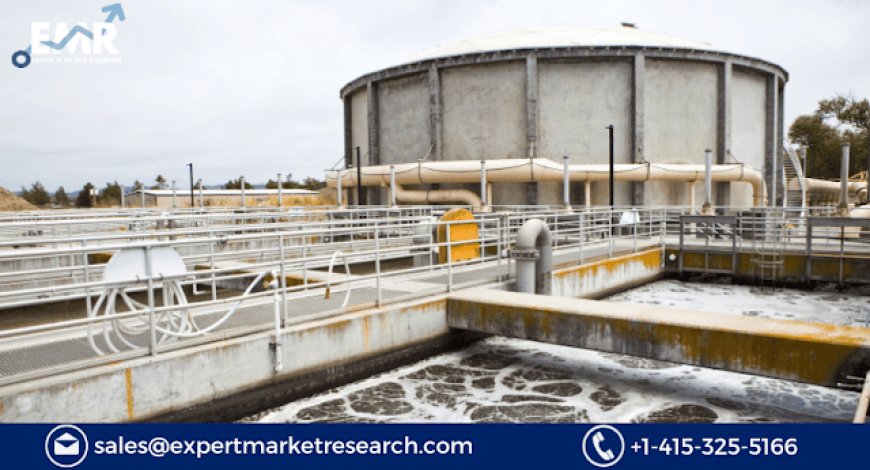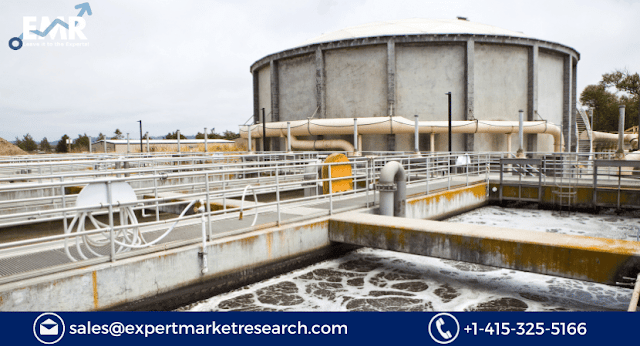Industrial Wastewater Treatment Market Outlook: Assessing the Size and Scope of a Vital Industry
Industrial Wastewater Treatment Market Outlook: Assessing the Size ... Digital Journal

Industrial Wastewater Treatment Market: Promoting Sustainable Development
PRESS RELEASE
Published July 31, 2023

Industrial wastewater treatment plays a critical role in safeguarding the environment and promoting sustainable development. As industries continue to expand worldwide, the need for effective wastewater treatment solutions has become increasingly important. The global industrial wastewater treatment market is expected to experience significant growth in the coming years. This report aims to provide an overview of the market size, trends, industry segmentation, outlook, and forecasts for the period of 2023 to 2028.
Market Size and Share:
The industrial wastewater treatment market has been witnessing substantial growth, driven by increasing environmental concerns, stringent regulations, and the need for efficient water management in industries. According to Expert Market Research, the global industrial wastewater treatment market size was valued at USD 12.45 billion in 2020, growing at a CAGR of 7.4% during the forecast period 2023-2028.
Trends in the Industrial Wastewater Treatment Market:
- Adoption of Advanced Treatment Technologies: Industrial wastewater treatment technologies such as membrane filtration, reverse osmosis, and electrochemical processes are gaining traction due to their effectiveness in removing contaminants from wastewater.
- Integration of IoT and Automation: The integration of the Internet of Things (IoT) and automation in industrial wastewater treatment systems allows for real-time monitoring, efficient resource utilization, and predictive maintenance.
- Focus on Water Reuse and Recycling: Industries are increasingly emphasizing water reuse and recycling to minimize water consumption, reduce costs, and mitigate the environmental impact of wastewater discharge.
- Shift towards Decentralized Treatment Systems: Decentralized treatment systems, such as onsite or modular wastewater treatment plants, are gaining popularity as they offer flexibility, scalability, and cost savings for industries in remote locations.
- Rising Adoption of Biological Treatment Methods: Biological treatment methods, including activated sludge, anaerobic digestion, and constructed wetlands, are being widely adopted due to their effectiveness in removing organic pollutants.
Get a Free Sample Report with Table of Contents
Industrial Wastewater Treatment Industry Segmentation:
The industrial wastewater treatment market can be segmented based on the following factors:
Treatment Method:
- Physical Treatment
- Chemical Treatment
- Biological Treatment
- Membrane Filtration
- Others
End-User Industry:
- Chemicals and Pharmaceuticals
- Food and Beverage
- Power Generation
- Pulp and Paper
- Oil and Gas
- Metals and Mining
- Others
Industrial Wastewater Treatment Market Overview and Outlook:
The industrial wastewater treatment market is witnessing robust growth due to increasing regulatory pressure, growing industrialization, and rising awareness about environmental sustainability. The market is highly competitive, with key players focusing on research and development activities to develop innovative and cost-effective treatment solutions.
North America and Europe currently dominate the market due to stringent environmental regulations and the presence of established industries. However, the Asia Pacific region is expected to witness substantial growth during the forecast period, driven by rapid industrialization, urbanization, and increasing government initiatives to address water pollution.
Read the Full Report with the Table of Contents
Industrial Wastewater Treatment Market Forecast Period (2023-2028):
During the forecast period, the industrial wastewater treatment market is expected to witness significant growth. Factors such as stricter regulations, population growth, urbanization, and increasing industrial activities in emerging economies will drive the demand for efficient wastewater treatment solutions.
Frequently Asked Questions (FAQs):
Q: What are the major factors driving the growth of the global industrial wastewater treatment market?
A: The major factors driving market growth include increasing environmental concerns, stringent regulations, and the need for efficient water management in industries.
Q: Which regions are expected to dominate the industrial wastewater treatment market during the forecast period?
A: North America and Europe currently dominate the market, but the Asia Pacific region is expected to witness significant growth due to rapid industrialization and government initiatives.
Q: What are the emerging trends in the industrial wastewater treatment market?
A: The emerging trends in the market include the adoption of advanced treatment technologies, integration of IoT and automation, focus on water reuse and recycling, decentralized treatment systems, and rising adoption of biological treatment methods.
Q: How is the market segmented in terms of treatment method?
A: The market can be segmented based on treatment methods such as physical treatment, chemical treatment, biological treatment, membrane filtration, and others.
Q: Which industries are the major end-users of industrial wastewater treatment solutions?
A: The major end-user industries include chemicals and pharmaceuticals, food and beverage, power generation,
SDGs, Targets, and Indicators
1. Which SDGs are addressed or connected to the issues highlighted in the article?
- SDG 6: Clean Water and Sanitation
- SDG 9: Industry, Innovation, and Infrastructure
- SDG 12: Responsible Consumption and Production
- SDG 13: Climate Action
- SDG 15: Life on Land
The article discusses the importance of industrial wastewater treatment in safeguarding the environment and promoting sustainable development. It highlights the need for efficient water management in industries, which is connected to SDG 6. The adoption of advanced treatment technologies, integration of IoT and automation, focus on water reuse and recycling, and rising adoption of biological treatment methods align with SDG 9’s goal of promoting sustainable industry practices. The emphasis on reducing water consumption, mitigating environmental impact, and addressing water pollution relates to SDG 12. Additionally, the article mentions the impact of wastewater discharge on the environment, which is relevant to SDG 13 and SDG 15.
2. What specific targets under those SDGs can be identified based on the article’s content?
- SDG 6.3: By 2030, improve water quality by reducing pollution, eliminating dumping, and minimizing release of hazardous chemicals and materials.
- SDG 9.4: By 2030, upgrade infrastructure and retrofit industries to make them sustainable, with increased resource-use efficiency and greater adoption of clean and environmentally sound technologies.
- SDG 12.4: By 2020, achieve environmentally sound management of chemicals and all wastes throughout their life cycle, in accordance with agreed international frameworks, and significantly reduce their release to air, water, and soil to minimize their adverse impacts on human health and the environment.
- SDG 13.3: Improve education, awareness-raising, and human and institutional capacity on climate change mitigation, adaptation, impact reduction, and early warning.
- SDG 15.1: By 2020, ensure the conservation, restoration, and sustainable use of terrestrial and inland freshwater ecosystems and their services, in particular forests, wetlands, mountains, and drylands, in line with obligations under international agreements.
Based on the article’s content, the targets listed above are relevant to the issues discussed. They focus on improving water quality, upgrading infrastructure for sustainability, managing chemicals and wastes, raising awareness about climate change, and conserving ecosystems.
3. Are there any indicators mentioned or implied in the article that can be used to measure progress towards the identified targets?
- Reduction in pollution levels and hazardous chemical releases in industrial wastewater
- Increase in the adoption of advanced treatment technologies
- Integration of IoT and automation in industrial wastewater treatment systems
- Increase in water reuse and recycling practices
- Implementation of decentralized treatment systems
- Increase in the use of biological treatment methods
- Improvement in education and awareness about climate change mitigation and adaptation
- Conservation and restoration of terrestrial and freshwater ecosystems
The article mentions or implies indicators such as pollution levels, adoption of advanced treatment technologies, integration of IoT and automation, water reuse and recycling practices, implementation of decentralized treatment systems, use of biological treatment methods, education and awareness about climate change, and conservation and restoration of ecosystems. These indicators can be used to measure progress towards the identified targets.
Table: SDGs, Targets, and Indicators
| SDGs | Targets | Indicators |
|---|---|---|
| SDG 6: Clean Water and Sanitation | 6.3: By 2030, improve water quality by reducing pollution, eliminating dumping, and minimizing release of hazardous chemicals and materials. | – Reduction in pollution levels and hazardous chemical releases in industrial wastewater |
| SDG 9: Industry, Innovation, and Infrastructure | 9.4: By 2030, upgrade infrastructure and retrofit industries to make them sustainable, with increased resource-use efficiency and greater adoption of clean and environmentally sound technologies. | – Increase in the adoption of advanced treatment technologies – Integration of IoT and automation in industrial wastewater treatment systems |
| SDG 12: Responsible Consumption and Production | 12.4: By 2020, achieve environmentally sound management of chemicals and all wastes throughout their life cycle, in accordance with agreed international frameworks, and significantly reduce their release to air, water, and soil to minimize their adverse impacts on human health and the environment. | – Reduction in pollution levels and hazardous chemical releases in industrial wastewater – Increase in the use of biological treatment methods |
| SDG 13: Climate Action | 13.3: Improve education, awareness-raising, and human and institutional capacity on climate change mitigation, adaptation, impact reduction, and early warning. | – Improvement in education and awareness about climate change mitigation and adaptation |
| SDG 15: Life on Land | 15.1: By 2020, ensure the conservation, restoration, and sustainable use of terrestrial and inland freshwater ecosystems and their services, in particular forests, wetlands, mountains, and drylands, in line with obligations under international agreements. | – Conservation and restoration of terrestrial and freshwater ecosystems |
Behold! This splendid article springs forth from the wellspring of knowledge, shaped by a wondrous proprietary AI technology that delved into a vast ocean of data, illuminating the path towards the Sustainable Development Goals. Remember that all rights are reserved by SDG Investors LLC, empowering us to champion progress together.
Source: digitaljournal.com

Join us, as fellow seekers of change, on a transformative journey at https://sdgtalks.ai/welcome, where you can become a member and actively contribute to shaping a brighter future.







